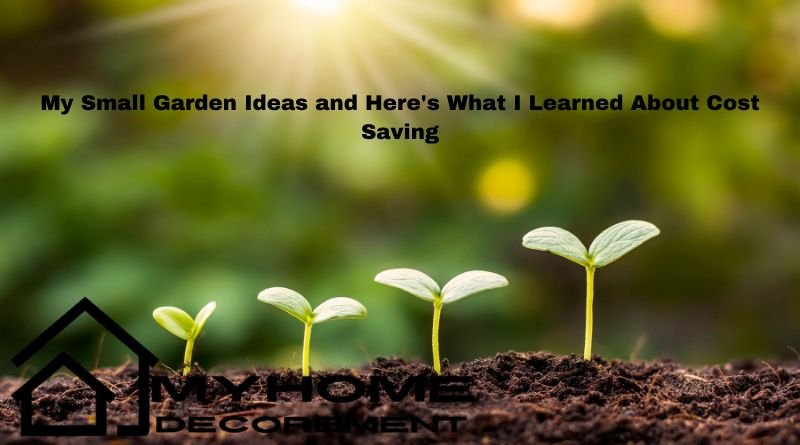Creating a beautiful and functional garden space can be both rewarding and challenging, especially when working with limited space and a tight budget. Recently, I took on the task of transforming my small garden, and along the way, I learned several cost-saving strategies that can help anyone achieve a lush and inviting garden without breaking the bank. Here, I’ll share my journey and the small garden ideas that made a significant difference.
Assessing the Space and Planning
The first step in any garden makeover is to assess the space and plan accordingly. This phase is crucial because it helps to identify the strengths and limitations of the garden area. In my case, I measured the dimensions of my garden and observed the sunlight patterns throughout the day. This information guided my plant selection and layout decisions, ensuring that each plant would thrive in its designated spot.
Planning also involves setting a budget. Knowing how much you’re willing to spend helps to prioritize expenses and avoid overspending. I created a list of essentials, such as soil, plants, and basic garden tools, and allocated funds accordingly. This organized approach not only saved money but also ensured that I focused on the most important aspects of the garden transformation.
Choosing Cost-Effective Plants
One of the most significant expenses in gardening is purchasing plants. However, with some research and creativity, it’s possible to find cost-effective options that still offer beauty and variety. I opted for perennial plants, which return year after year, eliminating the need for annual replacements. Perennials such as hosts, daylilies, and lavender are not only affordable but also low-maintenance, making them perfect for a small garden.
Additionally, I incorporated native plants into my garden. Native plants are adapted to the local climate and soil conditions, which means they require less water and fertilizer compared to non-native species. This choice not only reduces maintenance costs but also supports local wildlife and promotes biodiversity.
DIY Garden Features
Incorporating garden features such as pathways, borders, and decorations can enhance the aesthetic appeal of a garden, but they can also be expensive if purchased new. To save money, I embraced the DIY approach, using repurposed materials and creative solutions to add character to my garden.
For example, I created a garden pathway using old bricks and stones that I found in my backyard. This not only gave the garden a rustic charm but also eliminated the need to buy new materials. Similarly, I used reclaimed wood to build raised garden beds, which are excellent for growing vegetables and herbs in a small space. These DIY projects were both cost-effective and environmentally friendly, making them a win-win solution.
Maximizing Vertical Space
In a small garden, utilizing vertical space is essential to maximize the available area. Vertical gardening allows you to grow more plants without taking up valuable ground space. I installed a series of trellises and vertical planters along the walls and fences, creating a lush and vibrant vertical garden.
Climbing plants such as ivy, jasmine, and climbing roses are perfect for vertical gardens. They not only add greenery but also create a sense of height and depth in a small space. Hanging baskets and wall-mounted planters are also great options for growing herbs, flowers, and even small vegetables. By going vertical, I was able to increase my plant variety and density without overcrowding the garden.
Smart Watering Solutions

Watering can be a significant expense, especially in regions with hot and dry climates. To reduce water usage and costs, I implemented several smart watering solutions. First, I installed a rain barrel to collect and store rainwater. This free resource provided a sustainable way to water my plants without relying on tap water.
I also mulched my garden beds to retain moisture and reduce evaporation. Mulching not only conserves water but also suppresses weeds and improves soil health. I used organic mulch made from wood chips and compost, which are both affordable and beneficial for the garden.
In addition, I invested in a drip irrigation system, which delivers water directly to the plant roots, minimizing waste and ensuring efficient water usage. Drip irrigation systems are relatively inexpensive and can be easily set up with a bit of DIY effort. These smart watering solutions significantly reduced my water bills while keeping my garden hydrated and healthy.
Composting and Soil Improvement
Healthy soil is the foundation of a thriving garden, but high-quality soil amendments can be costly. To improve my garden soil without spending a fortune, I started composting kitchen scraps and garden waste. Composting is an excellent way to recycle organic material and create nutrient-rich compost that enriches the soil and promotes plant growth.
I built a simple compost bin using wooden pallets and placed it in a corner of my garden. Over time, I added vegetable peels, coffee grounds, grass clippings, and leaves to the bin, allowing them to decompose naturally. The resulting compost was a valuable resource that improved soil structure, increased fertility, and reduced the need for chemical fertilizers.
In addition to composting, I also used green manure crops such as clover and alfalfa to enhance soil health. These cover crops fix nitrogen in the soil, preventing erosion and improving soil texture. By focusing on natural soil improvement methods, I was able to create a fertile garden environment without incurring high costs.
Repurposing and Upcycling
Repurposing and upcycling materials not only save money but also add a unique and personal touch to the garden. Throughout my garden makeover, I looked for opportunities to reuse items that I already had or could obtain for free.
For instance, I used old tires as planters for flowers and herbs. With a coat of bright paint, these tires became eye-catching garden features. I also repurposed an old wooden ladder as a vertical planter, adding pots of colorful flowers to each step. These creative solutions not only reduced waste but also gave my garden a distinctive and whimsical look.
Garage sales, thrift stores, and online marketplaces are great places to find affordable garden items such as pots, furniture, and decorations. By keeping an eye out for bargains and thinking creatively, it’s possible to furnish and decorate a garden on a shoestring budget.
Community Resources and Shared Gardening
Gardening doesn’t have to be a solitary endeavor. Tapping into community resources and shared gardening opportunities can provide access to tools, plants, and knowledge without the associated costs. I joined a local gardening club, where members share seeds, cuttings, and gardening tips. This not only saved money but also allowed me to connect with fellow gardening enthusiasts and learn from their experiences.
Many communities also have public gardens or gardening programs where residents can borrow tools, attend workshops, and participate in communal gardening projects. These resources are invaluable for novice gardeners and those looking to expand their skills and knowledge.
conclusion,
transforming a small garden on a budget is entirely possible with careful planning, creativity, and resourcefulness. By choosing cost-effective plants, embracing DIY projects, maximizing vertical space, implementing smart watering solutions, improving soil naturally, repurposing materials, and tapping into community resources, I was able to create a beautiful and sustainable garden without overspending. These small garden ideas not only saved money but also enhanced the overall gardening experience, making it a fulfilling and enjoyable journey.
Read also: check



